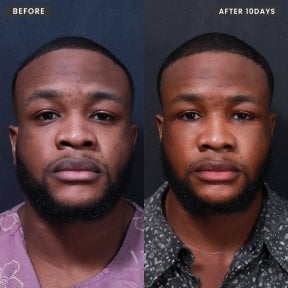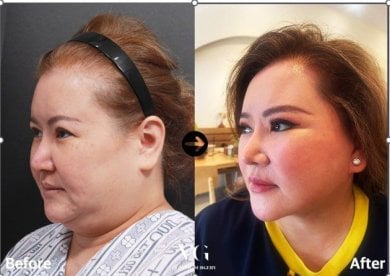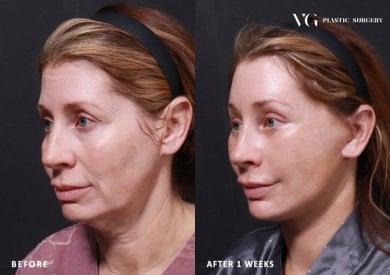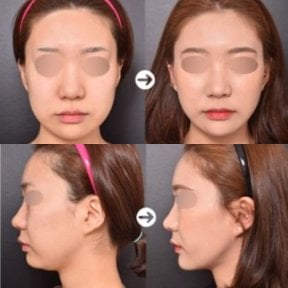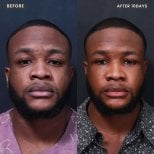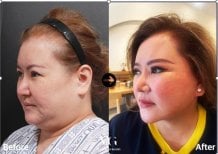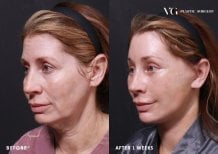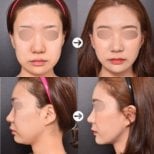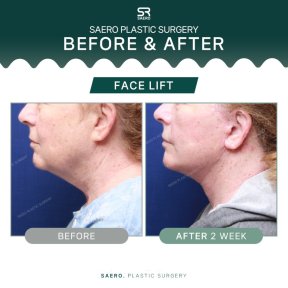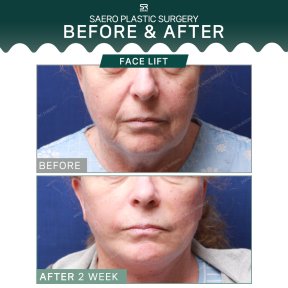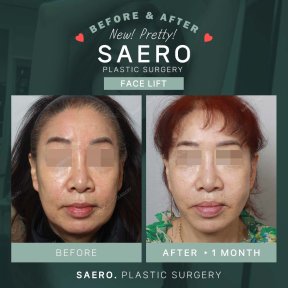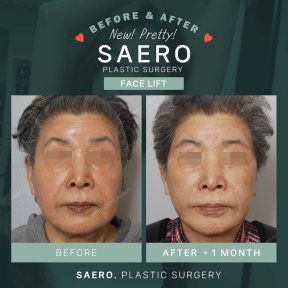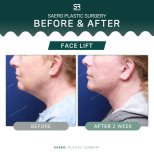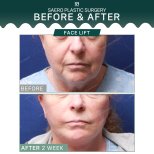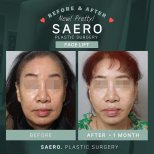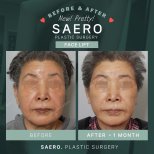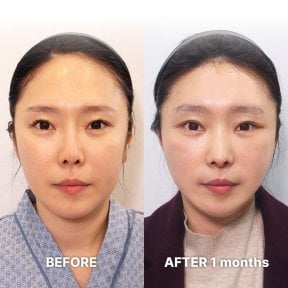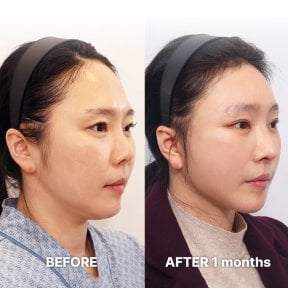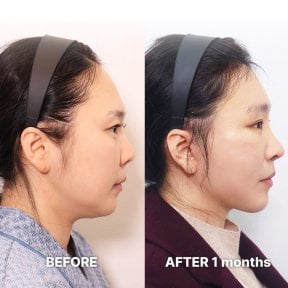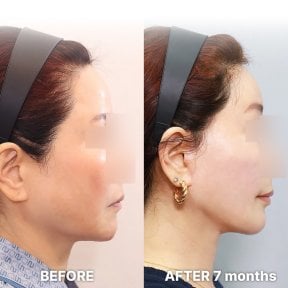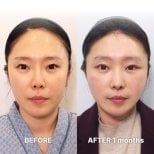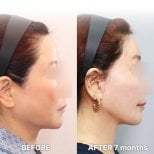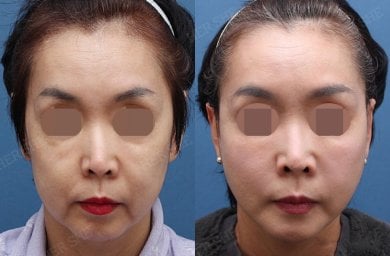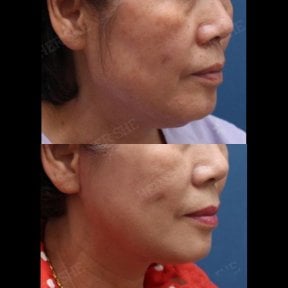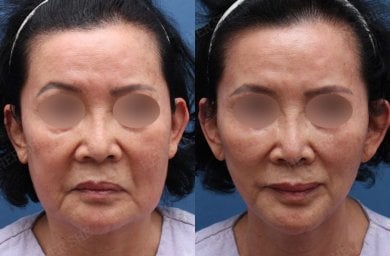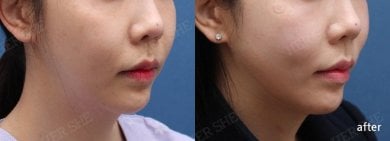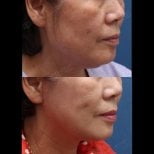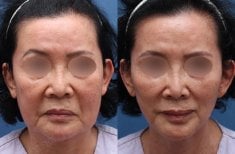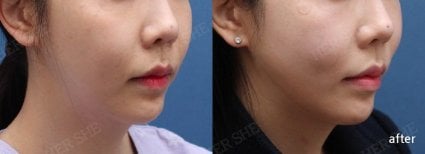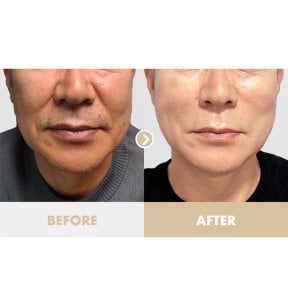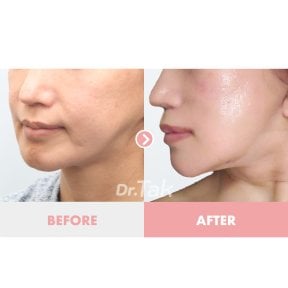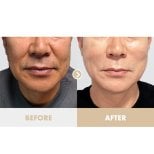What is a Korean face lift?
A facelift is a procedure that tightens sagging skin and repositions facial tissues for a more youthful look. It mainly targets the cheeks, jawline, and neck—areas where aging tends to show first.
A Korean facelift is a modern, expertly refined version of the traditional facelift surgery. It delivers facial rejuvenation while keeping results natural and elegant.
![faq image]()
Here’s what typically sets a facelift in Korea apart:
✔️ Natural-looking results. The goal is to look refreshed, not "done."
✔️ Tightening facial muscles at deeper levels (SMAS layer or deep plane) for longer-lasting effects.
✔️ Minimal scarring. Incisions are hidden behind the ears, along the hairline, or inside the mouth to minimize visible scarring.
✔️ Customized approach. Whether it's a mid-face lift, lower face, or full Korean lift, the plan is made just for the patient’s facial features.
Why choose Korea for a facelift?
![faq image]()
✦ Affordable prices
A facelift in South Korea costs 40%–70% less than in the US or Europe due to lower operating costs, a competitive market, the government’s support of medical tourism, and favorable exchange rates.
✦ Cosmetic surgery capital of the world
South Korea performs roughly 25% of the world’s cosmetic surgeries. That’s more than any other country per capita.
✦ Pioneering surgical innovations
Korean surgeons are known for developing new techniques that often reach the West years later. These include:
- minimally invasive facelift methods;
- Korean thread lift options using PDO or PLLA threads for a non-surgical lift;
- high-tech skin tightening devices, like Ultraformer III (HIFU) and Ulthera, which use focused ultrasound to contract collagen and lift loose skin without incisions;
- stem cell–enhanced facelifts that support collagen production and improve elasticity.
✦ Top-tier surgeons
With a population of just 51 million, it’s home to over 2,700 board-certified plastic surgeons—the highest density globally.
Korean plastic surgeons perform hundreds of facelifts each year and specialize in subtle transformations. They combine advanced techniques with a deep understanding of facial balance. The surgeons are members of international organizations like:
- International Society of Aesthetic Plastic Surgery (ISAPS);
- American Society of Plastic Surgeons (ASPS).
✦ Modern clinics with 5-star service
Korean hospitals often look more like luxury hotels than medical centers. English-speaking staff, private recovery rooms, and airport transfers are frequently included.
✦ Medical tourism hotspot
Each year, around 114,000 foreign patients come to South Korea for aesthetic surgery, including Korean facelift procedures. Clinics are well-prepared for international visitors, offering concierge-like service, English-speaking staff, and quick scheduling.
Who is an ideal candidate for a facelift in South Korea?
Ideal candidates for a facelift in Korea typically meet the following criteria:
✔ Have visible signs of aging (sagging facial skin, deep folds, jowls)
✔ In good health, with no severe medical conditions
✔ Non-smokers or willing to stop smoking before and after surgery
✔ Want natural-looking results that enhance, not alter, their facial identity
✔ Prefer refined, minimally invasive techniques developed by Korean specialists
What are the types of facelift surgery available in Korea?
South Korea offers a full range of facelift procedures, from surgical to non-surgical. The surgical options include:
- Traditional (full) facelift. Comprehensive facial rejuvenation addressing the mid-face and jowls. Traditional facelifts are often combined with neck lifts. Ideal for more advanced aging.
- Mini facelift. Focuses on lifting the lower face and reducing jowls using minimal incisions. Mini facelifts are best for patients with early signs of aging.
- SMAS facelift. Tightens both the skin and the muscular layer beneath the skin for a lifting effect without tension on the skin surface. Popular for creating a natural, rejuvenated appearance.
- Deep plane facelift. Lifts the deeper facial tissues rather than just the skin, creating exceptionally natural results. Deep plane facelifts are highly regarded in Korea for avoiding an "operated" appearance. Especially effective for severely sagging skin and deep nasolabial folds.
Non-invasive facelift options in Korea include:
- Liquid facelift. Uses fillers and Botox for temporary lifting (6–18 months) without surgery.
- Thread lift. A popular Korean lift using dissolvable threads to lift the skin subtly. Thread lift effects last 1–2 years.
- Laser lifting. Stimulates collagen production for gradual skin tightening—no needles or surgical procedures needed.
Korean plastic surgeons often combine these approaches based on individual facial anatomy.
Can you combine a facelift with other surgeries in Korea?
Yes, combining a facelift with other procedures is not only common but often recommended by Korean surgeons for a more balanced rejuvenation.
A facelift with a neck lift is the most common combination that addresses both facial skin and neck wrinkles. Korean surgeons consider this almost a standard pairing rather than separate procedures, as the neck and lower face aging are closely connected.
Other procedures that patients can combine with a facelift are:
What are the steps of a facelift in Korea?
A typical facelift procedure in Korea follows these key steps:
1. Consultation. Your surgeon analyzes your facial structure and aging patterns to create a customized plastic surgery plan.
2. Pre-op tests. Basic bloodwork, ECG, and other health checks.
3. Anesthesia. Surgeons usually use general anesthesia or IV sedation.
4. Incisions. Incisions are placed in discreet areas (around the ears, hairline, or under the chin).
5. Tissue repositioning. The surgeon lifts and tightens the sagging skin, SMAS layer, or deeper layers.
6. Fat grafting. Excess fat may be removed or repositioned to restore youthful facial contours.
7. Skin redraping. Excess skin is trimmed, and the remaining skin is gently redraped over the new contours.
8. Suturing & dressing. Incisions are closed with fine sutures; bandages or compression garments are applied.
9. Recovery & follow-ups. Patients receive post-operative care instructions, medications, and regular check-ins.
| Surgery time |
2–4 hours |
| Hospitalization |
~1 night for traditional facelift methods; outpatient for mini facelifts |
| Stitch removal |
4–7 days; not needed for dissolving sutures |
How long do you need to stay in Korea for a facelift surgery?
Most patients stay in South Korea for 7 to 10 days after their facelift surgery to allow time for follow-ups, stitch removal, and initial healing. Here's an example of a timeline:
- Day 1: Consultation and pre-op tests
- Day 2: Surgery
- Days 3–6: Rest and check-ups at the clinic
- Days 7–10: Final check-up and clearance to fly home
Some clinics may recommend a slightly longer stay (up to 2 weeks) for more complex procedures or if combined with other surgeries.
What is recovery like after a Korean lift?
| Recovery phase |
What to expect
|
| Week 1 |
Swelling and bruising peak. Rest is key. Pain is managed with meds. |
| Week 2 |
Swelling and bruising fade. Some numbness or tightness is normal. Most patients return to light daily activities or work. The face looks presentable to the public. |
| Weeks 3–4 |
Facial contour improves. Exercise can resume. Incisions may appear pink but are healing well. |
| After 1 month |
Most normal activities resume. Minor swelling and tightness may persist, but are only noticeable to the patient. |
| Months 2–3 |
The face feels completely “back to normal”. |
What are the potential risks of a Korean facelift?
Facelift surgery is overwhelmingly safe—98.2% of procedures result in no complications.
However, as with any surgery, rare risks may occur:
- hematoma;
- scarring;
- temporary nerve injury;
- temporary hair loss.
Bookimed helps reduce these risks by connecting patients only with verified Korean clinics and top-rated plastic surgeons.
What are the long-term results of a Korean facelift?
A Korean facelift delivers long-lasting, natural-looking results that last around 10 years.
Long-term benefits include:
- lifted facial contours;
- a more defined jawline;
- smoother skin with fewer deep lines.
Studies show that people appear about 6 years younger to others after a facelift.
Over time, the natural aging process continues, and skin may begin to sag again. To prolong facelift results, it’s recommended to use daily sun protection and maintain a healthy lifestyle.
What is the price of a facelift in Korea?
Facelift prices in South Korea vary between $2,000 and $13,500, depending on the type of procedure.
| Type of facelift |
Estimated price (USD) |
| Mini facelift |
$2,000–$6,000 |
| Traditional facelift procedure |
$9,000–$13,000 |
| Premium SMAS facelift |
$13,500+ |
By comparison, a facelift in the United States averages $18,000 and can reach $50,000 at top-tier clinics. That means patients can save up to 70% by choosing a Korean lift.
What’s included in a facelift package in Korea?
Korean facelift packages are designed for medical tourists and include more than just surgery.
| Usually included |
Additional inclusions in premium packages |
| Consultation with a plastic surgeon |
Chest X-ray and echocardiography |
| Anesthesia |
Hyperbaric oxygen therapy for faster recovery |
| Pre-op blood tests |
Skin booster and vitamin infusions |
| Mini, SMAS, or full facelift procedure |
Cosmetic recovery kits |
| Follow-up visits and dressing changes |
24/7 nurse support |
| Compression garments |
Full board meals (breakfast, lunch, dinner) |
| Basic post-op wound care |
Beauty services (e.g., hair wash after surgery) |
| Transfers between the airport, the clinic, and the hotel |
Nutritionist services |
| Language assistance |
|
Are there any alternatives to a facelift in Korea?
Yes, Korea is a global leader not only in surgical facelifts but also in non-surgical facial rejuvenation.
If you’re not ready for surgery, less invasive methods include:
- Non-surgical facelifts, such as liquid lifts, thread lifts, and laser lifting.
- High-intensity focused ultrasound (HIFU) that tightens deeper layers by boosting collagen.
- Laser skin resurfacing that removes damaged outer skin layers and stimulates collagen; great for fine lines and texture.
- Chemical peels that apply exfoliating acids to reduce pigmentation, dullness, and facial wrinkles.
- Microneedling that uses ultra-fine needles to gently stimulate collagen production; improves firmness and skin tone.
- Radiofrequency (RF) treatments that gently heat soft tissues to improve skin elasticity.
Resources
- Mayo Clinic. (2022). Face-lift.
- ISAPS. (2023). International Survey on Aesthetic/Cosmetic Procedures Performed in 2023.
- Statista. (2024). Number of foreign patients who visited plastic and cosmetic surgery departments in South Korea from 2009 to 2023.
- Aesthetic Surgery Journal. (2021). How to Prevent and Treat Complications in Facelift Surgery.
- JAMA Facial Plastic Surgery. (2018). Association of Face-lift Surgery With Social Perception, Age, Attractiveness, Health, and Success.

